Upon completion of any new FM200 pipework installation or modifications to an existing system, there will be a requirement to complete a pressure [40 psi for 10 minutes] and puff/flow test to ensure the system’s integrity before being put into permanent operation.
Below we will run through the following items using NFPA 2001, Standard on Clean Agent Fire Extinguishing Systems as a reference, the specific manufacturer’s information including any local codes/regulations should also be reviewed to ensure everything is captured.
- Visual Inspections
- General Information
- Required Documentation
- Tolerances and system details
- Pneumatic Pressure Test Method
- Puff / Flow Test Method
If want to read more on the FM-200 system, see our article 'FM200 SYSTEM | What is it?'

Who will complete and validate the FM200 pressure testing?
Due to the criticality of the system and method of test, pneumatic, possibly having significant health and safety implications, only engineers who are qualified and experienced in the works should conduct the testing.
Witnessing, where required would be the responsibility of clients representative, usually the Commissioning Provider or Facility Management Department, and they should make themselves available when needed.

Health & Safety
Health and safety should be a concern during these works due to the pressure and tasks being conducted.
Areas to consider would be:
- Qualifications of operative
- Installation/removal/filling and manual handling of FM200 cylinders
- Installaiton and connection of system valves and controls
- Working at height
- Working with pressurized gas
- Pneumatic pressure testing
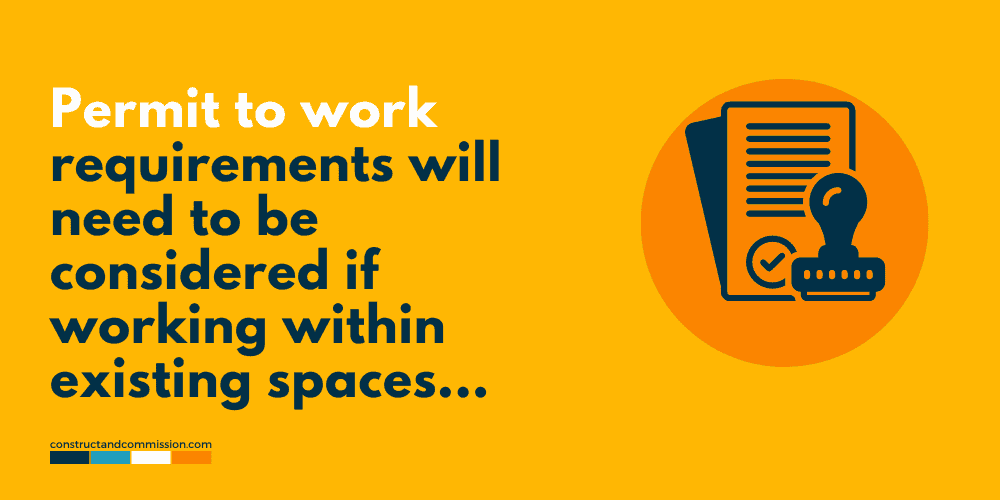
Permit to work
Permit to work documents should be detailed and included to ensure that the relevant requirements to allow testing the equipment and pipework are met, items to include would be:
- General access to site
- Access to specific space equipment and pipework is located and,
- Life safety system isolations
[see testing procedure at end of this article for example]
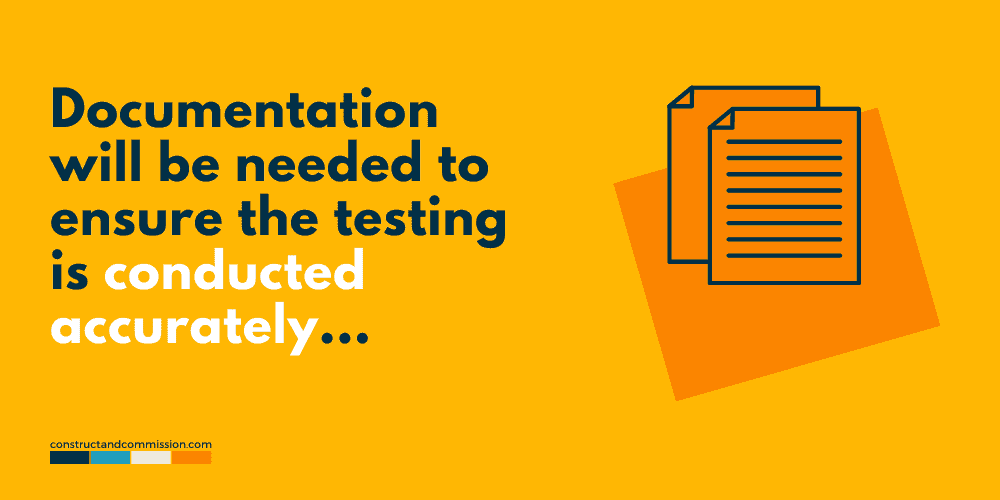
Documentation required
Prior to any testing starting, there will be a need for certain documentation to be available such as:
- Completed and approved checklists
- Approved material submission
- Approved construction drawings showing installation
- Completed and approved pre-functional testing checklist
- Approved method statement or functional testing procedure
- Self testing records [if system being witnessed by a third party]
Delivery Inspection Checks
Evidence should be obtained that prior to the pipework and/or FM200 system being accepted from the delivery company/supplier, a full check should be completed to ensure that the delivery meets the order and that the pipework and equipment are not damaged or anything missing.
Any damage or missing items should be notified to the supplier and delivery company immediately, with photographic evidence.
[see testing procedure at end of this article for example]
[083]
OPEN TEMPLATE of our PNEUMATIC PRESSURE & PUFF TESTING Method Statement including INSTRUCTIONS, that can be downloaded allowing editing and clean exporting for your project/company use.
All as per the format and layout shown in the sample document, at the end of this article.
Storage Inspection Checks
If pipework is to be placed into storage after delivery then there will usually be a project requirement to complete a storage inspection checklist. This will evaluate the space/area where the pipework will be kept and how stacked and stored to ensure it is clean, safe, and protected from damage prior to installation.
[see testing procedure at end of this article for example]
Installation and Pre-Commissioning Inspection Checks
Through the construction process and prior to any testing there is usually a requirement to conduct various installation and pre-commissioning checks covering:
- Pre-Installation
- Maintenance and access
- Pre-commissioning
These can be quite detailed and especially for this type of work and criticality of the FM-200 system.
[see testing procedure at end of this article for example]
Approved material submission
Although it seems a bit excessive, the approved material submission is useful and should be provided at the test to allow verification to prove that the materials and equipment used in the installation match and the client is getting what is paying for.
Approved construction drawings
Approved construction drawings should be provided and marked up with the testing area.
This is 1. to show where the testing will take place and, 2. to document the overall system testing for tracking purposes.
Self test records
If the pressure/puff/flow testing is being witnessed by a third party [commissioning provider, designer, facilities engineer], it should be fully self-tested prior to the witnessing.
This is to ensure that there are no issues and will reduce problems and return visits that could be claimed for.
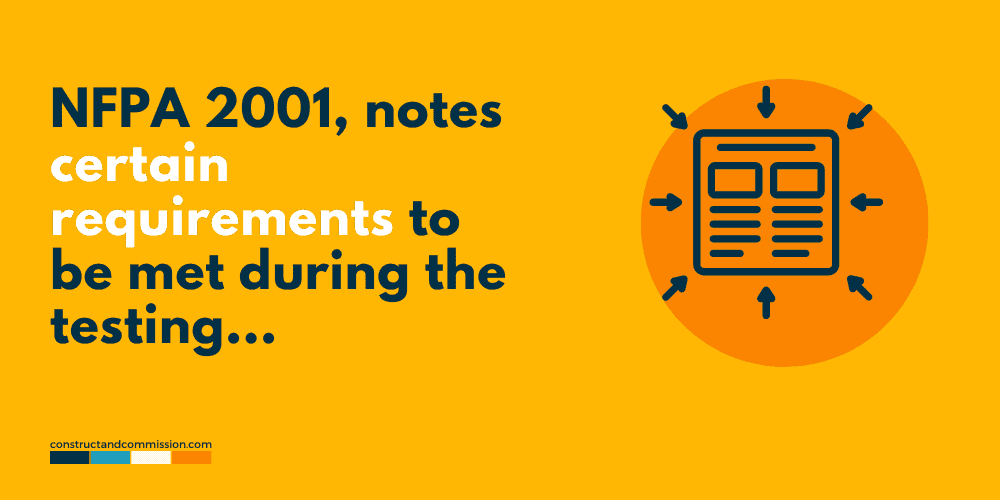
Acceptance criteria & tolerances
A section in the testing documentation should be included to explain and describe any specific testing information such as system pressures, testing pressures, tolerances and testing times, etc.
For the FM-200 pipework pressure testing and puff/flow test we would include the below:
| Code Document | Code Section | Test Information | Tolerance Allowed |
|---|---|---|---|
| NFPA 2001 | Chapter 10 [10.4.14.1] | Using 40 psi / 276 kPa / 2.7 bar for a period of 10 minutes | Drop not to exceed 80% of the initial test pressure |
| NFPA 2001 | Chapter 10 [10.4.15] | Using nitrogen or inert gas conduct a Flow/Puff Test for a short duration | n/a |
Note: Inline with NFPA 2001 Chapter 10 [10.4.14.3] – Pressure testing is not required if the pipework installation contains only one change of direction between the FM200 cylinder and discharge nozzle, as long as a fully comprehensive inspection has been completed for tightness.
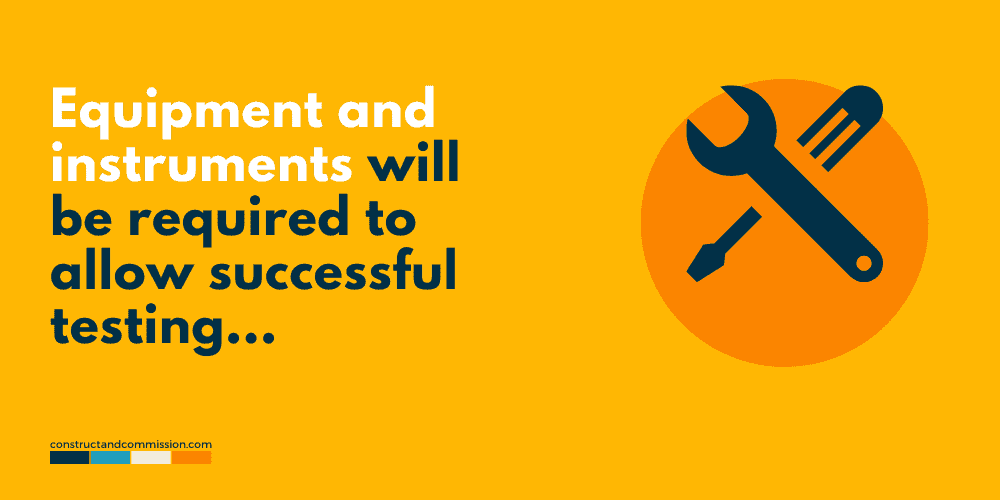
Testing equipment
We should detail any equipment and instruments that are to be used during the testing, especially if they are to be calibrated.
For calibration, all equipment and instruments used will need a certificate that is in date matching the serial number.
| Equipment Type | Calibration Certificate expiry date | Model | Serial Number |
|---|---|---|---|
| Pressure Gauge | |||
| Temporary Pressure Rated Hoses | |||
| Caps for blanking heads | |||
| Nitrogen or Inert Gas | |||
| Temperature & Humidity Handheld Sensor | |||
| Ribbon for Puff Test | |||
| Hand Tools |
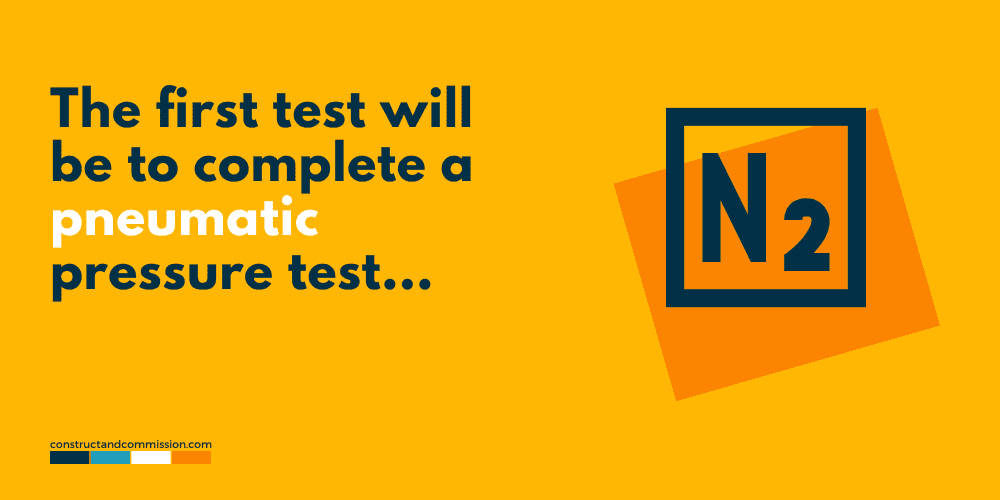
Pneumatic pressure test method
Note: the below is provided as an example, its a very common method of testing but be aware that projects can be different
To complete the pneumatic pressure testing of the FM-200 pipework system, the following steps should be completed using Nitrogen Gas:
| Step | Description |
|---|---|
| 1 | Ensure all pre-requisites and pre-functional testing checks have been completed. |
| 2 | Remove all discharge nozzles and replace with blanking caps. |
| 3 | Connect the nitrogen bottle via the temporary hoses, valves, and pressure gauge, at the system lowest point, to the valve assembly/connection point. |
| 4 | Introduce pressure into the system slowly until the pressure gauge reads 40 psi / 276 kPa / 2.7 bar. |
| 5 | Once at the required pressure, and with the nitrogen still attached and isolating valve closed, wait 2 minutes for the system to settle. If there is a drop-in pressure and no obvious leaks increase pressure via the nitrogen bottle until test pressure is reached. |
| 6 | Isolate the nitrogen bottle via the temporary valve to ensure no additional pressure can be put into the system. |
| 7 | Take air temperature readings in the spaces and document them on the pressure test certificate. |
| 8 | Note the testing start time and date on the pressure testing certificate for the record, photographing the test gauges for evidence [if required]. |
| 9 | Walk the system checking for any leaks for the period of the test and checking the pressure gauge(s) for signs of any movement. |
| 10 | The test should be aborted and investigations made with remedial action taken if the test pressure moves outside of the required tolerance. |
| 11 | If no issues are noted then continue the test until the period of 10 minutes has been completed from the documented testing start time. |
| 12 | Review the pressure gauges for the final time, to see if there is any drop in pressure and ensure inline with the allowed tolerances. |
| 13 | Once the time has elapsed for the required test and it is deemed to be accepted by the relevant parties in attendance, the testing will be complete. |
| 14 | Photographic evidence should be taken with all information entered the pressure test certificate. |
| 15 | Release the pressure from the system safely and disconnect the pressure gauge etc. |
| 16 | Move to the puff/flow testing stage. |

Puff/flow testing method
The reason for conducting a ‘puff/flow’ test is to ensure that there is a continuous flow through the pipework and to ensure all valves are installed correctly and in the correct direction.
To conduct this test the following steps should be followed.
| Step | Description |
|---|---|
| 1 | Re-install all FM-200 discharge nozzles/heads |
| 2 | At each discharge nozzle, tie a piece of ribbon, so that it can flutter when the air is passing through the nozzle, providing a visual indication. |
| 3 | Ensure a bottle of nitrogen/temporary hoses are connected at the cylinder connection to the system. |
| 4 | Once ready open the valve on the nitrogen bottle to allow it slowly through the pipework system. |
| 5 | As the nitrogen passes through the system the ribbon tied to the discharge heads should flutter, proving the flow is continuous and that all system valves are in the correct direction. |
| 6 | Once the test is deemed to be accepted by the relevant parties in attendance, close off the valve stopping the nitrogen from flowing. |
| 7 | Disconnect the temporary hoses and remove the ribbons from the discharge nozzles. |
| 8 | Complete all documentation/certificates to prove the testing was successful and take photographic evidence [if required] |
FM200 Pneumatic Pressure & Puff/Flow Testing Method Statement Download [PDF]
To help us expand the site and create more resources, we have created the below documentation in [Microsoft Word] for download.
Click the ‘Buy Here‘ button to purchase the fully editable copy of the document below, which can be used straight away.
You will direct to our shop page.
⬛ Related Articles
FM200™ SYSTEM | What is it?
FIRE SPRINKLER SYSTEMS | 4 Types Explained
FM200™ PIPEWORK | Pre-Commissioning Check List
CLEAN AGENT | Room Integrity Testing Requirements
CLEAN AGENTS | What are they, Types & Benefits
GAS SUPPRESSION / FM 200 SYSTEM | Pre-Functional Checklist


![FM-200 Pneumatic Pressure & Puff Testing Method Statement Template [MS Word]](https://constructandcommission.com/wp-content/uploads/2022/01/083.webp)